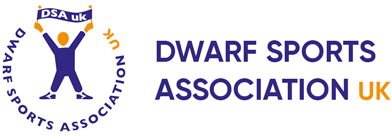There are over 200 types of restricted growth which can be grouped together as dwarf conditions, the most common being Achondroplasia. There are a few skeletal and potential joint stability problems sports coaches should keep in mind when working with athletes who have a dwarf condition
Many people with Achondroplasia have a Kyphosis or Scoliosis of their spine and constant shock to the back can cause damage to this area. They may have a spinal stenosis which is a pinching of the spinal column caused by having restricted room within the vertebrae for the spinal column to pass through.
Persons with restricted growth can have quite lax joints and their elbows, hips, and knees especially can be unstable. This is usual seen in the joints being extremely flexible, many dwarf athletes can have a bowing of the legs which may result in problems with ankles.
We believe that athletes with a restricted growth condition or dwarfism benefit greatly from regular exercise and competition.
The Dwarf Sports Association has a national games which are held annually many of athletes also move on to DSE events and start to train with local sport specific clubs.
An individual participating in sport at school can be involved in most activities and we believe this is important for their development and integration with their peers. Many of our athletes enjoy a spectrum of different sports during their school years. The more involved in regular exercise individuals are, the better the muscle tone around problem areas is maintained and therefore the more stable these joints become.
We as an association, do however discourage our members from certain sports which may repeatedly apply a shock into the spinal area. In general we are of the opinion that Trampoline, High Jump, Long Jump, and Gymnastics have potential to cause long term damage to people with restricted growth conditions. We see this as a guideline as to what we consider unsuitable sports for people who live with a restricted growth condition.
Regular exercise can make a big difference to the lifestyle and wellbeing of a person who has a dwarf condition. It helps to keep body weight under control, which is paramount in working towards a healthy lifestyle. Keeping weight off and regular exercise can prevent and delay the need for invasive surgery to stabilise back and joint problems.
Below is a list of events which our athletes compete in at either national and Paralympics level or just as a means of exercise
Athletics
Dwarf Athletes compete in sprint events up to 200m. They also are particularly good throwers, enjoying, Javelin, Shot and Discus events. There is a Paralympic Pathway for some throws events.
Swimming
Swimming is a particularly good sport as it is non load bearing on the joints. There is the S6 and S7 classes for dwarf swimmers. There are Paralympic events for dwarf swimmers.
Badminton
Dwarf players in class 2 play a standard game of Badminton to standard rules. Class 1 players play in a half court. This sport is particularly popular with dwarf athletes. There are European and World events to strive for.
Powerlifting
The power lift takes the form of a bench press. Many dwarf lifters are gifted in this event and can lift many times their own body weight. This is a sport which requires expert coaching and tuition. There is a Paralympic pathway in this event.
Table Tennis
Dwarf players play to standard rules on a standard table. There is a Paralympic route in Class 7, though this is a mixed class with average height players. Table Tennis is a popular event at the National and World Dwarf games.
Boccia
This is a sport which many dwarf athletes enjoy. There is a Pan Disability League which dwarf players are welcome to join. The DSA also runs a National Championship Competition every year.
Football
Football is played to seven a side rules using 5 a side size goals. There is a successful GB team who compete at the world dwarf games. At the DSA national Games there are junior and senior leagues played.
Basketball
Basketball is played to standard rules on standard height nets for over 16yr old players. The under 16’s team use nets at 8’6″ height. It is played in leagues at the National DSA Games and at the world dwarf games.
Hockey
Uni Hockey is a popular team sport played by both Junior and Senior players. It is generally only played at the DSA National games.
Cycling
Cycling is becoming a more popular sport for dwarfs, there are custom built bikes and some standard models which can be ridden and raced. There is a cycling time trial at the DSA National games. This is a sport in development for dwarfs.
Other sports
Other sports enjoyed and organised by the DSA regions are: Shooting, Skiing, Archery, Fencing, Ten Pin Bowling, Snow Boarding, Climbing, Outward bound weekends, Canoeing and Sailing. Others have been tried as taster days also.
If you are working with any individual who has a dwarfism condition either as a coach or teacher then we advise that you make contact with the Dwarf Sports Association through the contact page on this website for advice and information on both the conditions and the sports.
If properly coached and supervised there is no reason for any person with a dwarf condition not to experience a full life enjoying an active lifestyle and excelling in the sport of their choice.
These tips and advice can be backed up by contacting our DSAuk coach, who can be contacted on 07801 887918.

